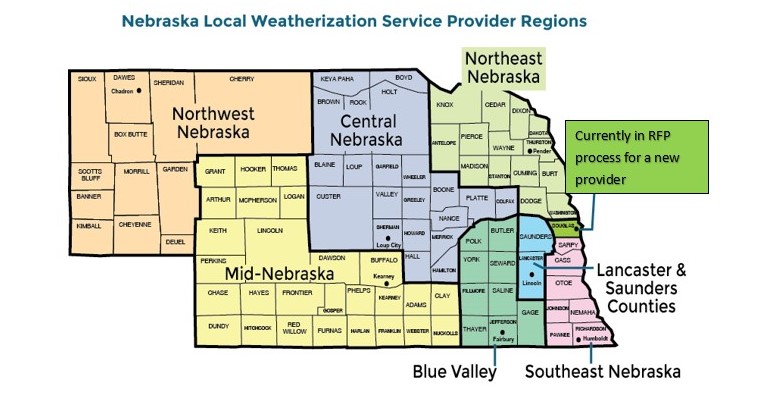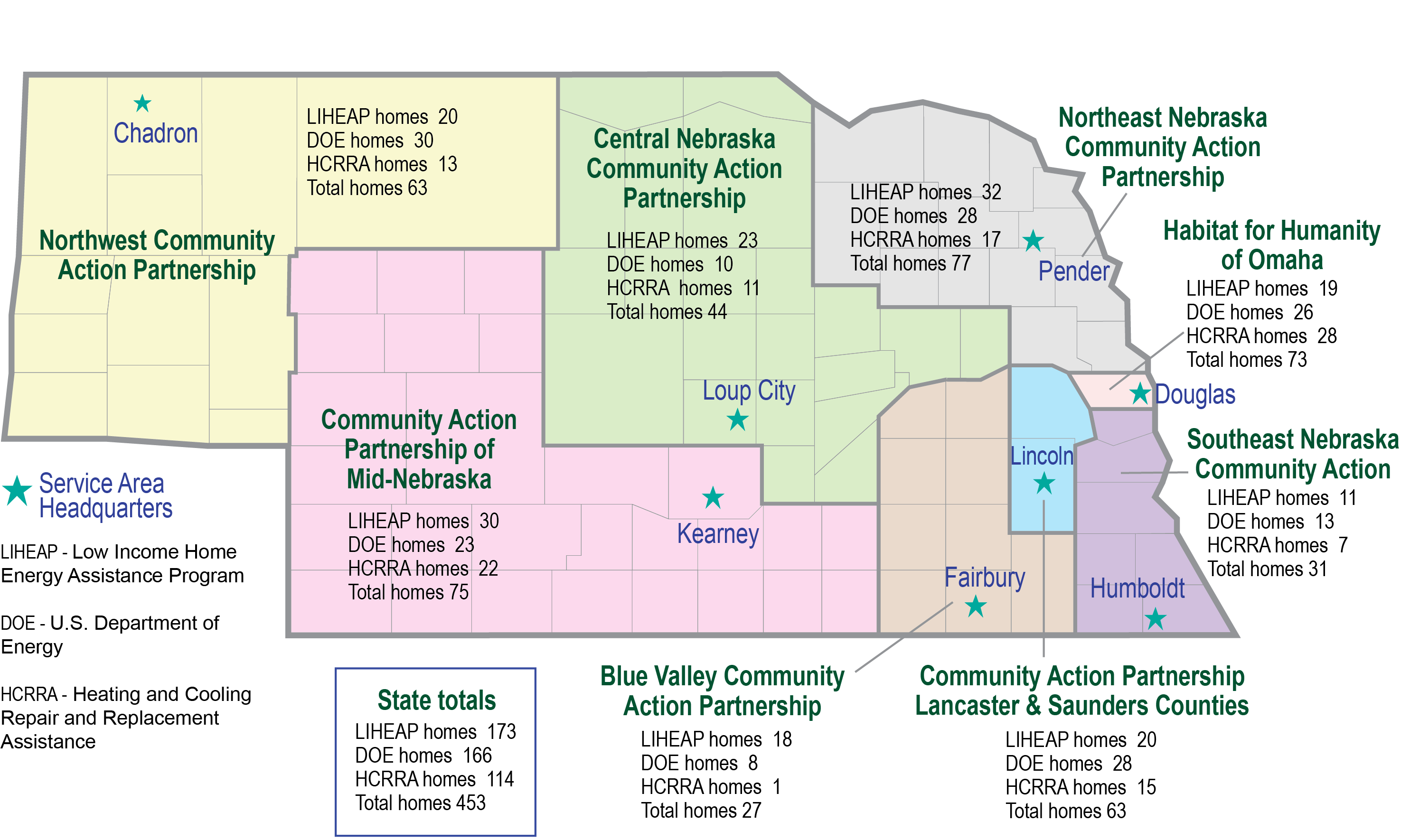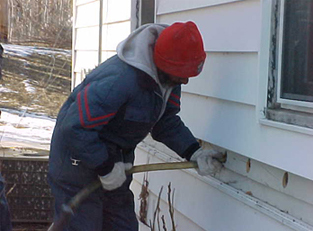Nebraska Weatherization Assistance Program
Weatherization enables low-income families in Nebraska to reduce their energy bills by making their homes more energy efficient.

P.O. Box 98922|Lincoln, NE 68509
Phone (402) 471-2186 | Toll Free (877) 253-2603
Weatherization enables low-income families in Nebraska to reduce their energy bills by making their homes more energy efficient.
You may apply online for bill paying assistance at the Nebraska Department of Health and Human Services website.
To file a Natural Gas Utility Complaint contact the Nebraska Public Service Commission.

To receive free weatherization services for your home, your income must fall below 200% of the federal poverty level, which is revised annually.
Note: Households with persons receiving either ADC (Aid to Dependent Children) or Supplemental Security Income (SSI) are automatically eligible for free weatherization.
For more specific information about the Weatherization Assistance Program, contact your service provider.
For more information about the Income Poverty Guidelines, see US DOE Weatherization Program Notice 22-3.
| Household Size | Income Threshold | 200% of Poverty Level |
|---|---|---|
| 1 | $15,060 | $30,120 |
| 2 | $20,440 | $40,880 |
| 3 | $25,820 | $51,640 |
| 4 | $31,200 | $62,400 |
| 5 | $36,580 | $73,160 |
| 6 | $41,960 | $83,920 |
| 7 | $47,340 | $94,680 |
| 8 | $52,720 | $105,440 |
| For families
with more than 8 persons |
100% of poverty level increases
$4,720 for each additional person |
200% of poverty level increases
$9,440 for each additional person |

If you meet the income requirements and are approved for weatherization assistance services in Nebraska, your home will be evaluated to identify the most effective energy and dollar saving improvements which can be made. The amount of money that can be spent on each home is limited, so all of the improvements listed below may not be made in each home.
After the improvements are made, you should notice the following:
Nebraska weatherization service providers utilize “whole house weatherization.” Under this approach, providers evaluate the house as a single energy-consuming system, rather than a loose collection of unrelated systems. This approach finds the best combination of methods for reducing total energy consumption in a house.
The first step in whole-house weatherization, and perhaps most important one, is to evaluate a house. Trained technicians use advanced computer software and diagnostic equipment to identify the most cost-effective energy-saving improvements for a particular home during an energy audit.
Reducing the leakage of cold outside air into the house in winter — or hot outside air in the summer — is the most common type of weatherization improvement made in a home. Typically, work crews add caulking and weather stripping around windows and doors to reduce drafts. Old, drafty homes are not only uncomfortable, but they are also very costly to heat and cool.
Tests using blower doors reveal more precisely the holes in the building envelope where outside air infiltrates into the house. Such holes often occur near the base of the building and near the roof and are unobservable to the naked eye.
The blower door is one of many tools that is used to assess a home for health, safety, durability, and energy efficiency. With the assistance of a blower door, air leakage tests are conducted to measure and quantify the air tightness of a house. The blower door depressurizes the house, sending air out through a fan and bringing air in from leaks in the building’s exterior.
With the readings from the gauges and house volume calculations, how well a home is ventilated can be determined. At this point, technicians walk around and look for the leaks in the building envelope. Sealing leaks to the exterior of the home — and blower door testing after the leaks have been sealed — will quantify the results and assess the need for additional sealing.
Making sure there is enough insulation in the walls, foundation, and roof — anywhere there is a barrier between the home and the outside — is one of the most important ways to make a home energy efficient. As a result, insulation is a part of almost every weatherization project.
Installing insulation with a uniform coverage and density is very important because the wall cavities are like chimneys. Air leakage can greatly reduce insulation’s thermal performance. The installer must inspect walls for structural soundness of the home before any insulation is added.
In some cases, furnaces may be replaced because of cracked heat exchangers or severe malfunction. Removing such hazards from homes reduces fires, injuries and health problems for occupants.
A safety inspection of the heating system is performed first, including:
A combustion test is performed to collect information on safety and efficiency. The system is also tested to make sure it does not back-draft in adverse conditions, such as when all the ventilation fans are operating in the house. Fans can have an impact on the how well a heating system vents.
Weatherization work crews always examine energy-related health and safety issues in the home. This is especially important when dealing with combustion heating equipment because faulty equipment can be hazardous to those who live there.
An important component of the weatherization process is client education. Client lifestyle choices can play a big role in determining the amount of energy and money actually saved. Clients are provided with tips on saving energy and information on how to maintain the energy efficiency improvements that have been made.

Eight non-profit organizations provide local weatherization services. They are responsible for establishing eligibility, performing an energy audit on the residence, and scheduling the weatherization work.
Click on your county on the map below to find weatherization services in your area.
Please remember that weatherization services can only be provided if the state has funds available. Weatherization assistance is not an entitlement program, meaning you are not guaranteed the services just because you are eligible. Congress provides a certain amount of money for weatherization assistance which varies from year to year. Please be patient if you are put on a waiting list. Your home will be weatherized as soon as possible.


Weatherization makes homes more energy efficient. Weatherization of a home typically involves the installation of attic, wall and floor insulation and sealing holes and cracks with caulking, weatherstripping and other types of materials. In addition, all furnaces, cooking stoves and water heaters receive a safety inspection.
Weatherization services do not include roof replacement, siding repairs, or replacement windows.
An estimated 51,000 Nebraska households are eligible for weatherization assistance services. Preference is given to persons over 60, persons with disabilities, and families with children under six.
Eligibility is limited to households with incomes at or below 200 percent of the federal poverty level. Eligibility income levels rise based on the number of persons living in the home. Income guidelines are listed here. Households containing a member who is receiving either Aid to Dependent Children or Supplemental Security Income are automatically eligible to receive services.
Eight, non-profit organizations provide local weatherization services. They are responsible for establishing eligibility, performing an energy audit on the residence, and scheduling the weatherization work. Find a weatherization provider in your area.
Congress provides funds for weatherization assistance which varies from year to year. Please be patient if you are put on a waiting list. Your home will be weatherized as soon as possible. Learn about the average number of homes weatherized in your area.
Yes, both homeowners and renters are eligible, whether you live in a single-family home, multi-family housing complex, or a mobile home, you can apply for assistance. However, renters must receive written permission from their landlords to weatherize their homes or rental units and restrictions apply.
All weatherization services are provided at no cost. However, if a furnace or water heater in a rental home is found to be unsafe, it is the responsibility of the property owner to replace or repair the appliance before weatherization of the home can begin.
Yes, typical improvements to mobile homes include underbelly insulation, window sealing and sealing air leaks.
Weatherization reduces your energy bills for a long time. After a home has been weatherized, energy used for heating is often reduced by up to 25 percent. Some improvements, such as insulating your walls or attic, for example, will continue to provide savings for the lifetime of the home -- 30 years or more.
Other improvements, such as making heating or cooling equipment more efficient, will provide savings for 10 to 15 years. On average, the value of the weatherization improvements to a house is 2.2 times greater than the cost of the improvement itself.
No, a home may be re-weatherized only if 15 years have passed since the completion of the original services.
Staff from your local or regional weatherization service provider conducts an assessment or energy audit of the home. The provider is a local nonprofit organization specially trained in home weatherization. The energy audit is a computerized assessment of your home's energy use and an analysis of which energy saving improvements are best for your home.
Once the audit is complete, the auditor or weatherization staff member will meet with the homeowner or renter to explain how the work crews will conduct the work. Depending on the assessment, some homes will receive more work than others. The average value of weatherization services provided is $7,500.
Throughout the weatherization process, the health and safety of a household is a priority. Following the weatherization, a Weatherization Assistance Program Inspector will visit to make certain that everything is working properly and that nothing was missed.

The number of homes that can be weatherized in any given year is dependent on the amount of funding allocated by Congress to the Weatherization Assistance Program.
In Nebraska, funds are divided among the local nonprofit organizations that provide weatherization services to Nebraskans. The amount given to each organization is based on several factors including the number of low-income Nebraskans living in the counties served by the local nonprofit organization.
The map below illustrates the total number of homes weatherized by local weatherization service providers.


The Nebraska Department of Environment & Energy administers this federally funded program for weatherizing homes to save money and energy.
The Nebraska Department of Environment & Energy Weatherization Assistance Program began in 1977. In 2010, maximum household income levels were revised to 200 percent of the federal poverty guidelines, making free home weatherization available to thousands of Nebraskans.
Energy savings resulting from the energy efficiency improvements made typically last 20 years or longer.
Energy expenses comprise an economic drain on low-income communities. Often, energy bills account for more than 20 percent of a family’s gross income. Typically, more than 80 percent of this expense leaves the community.
In contrast, weatherization reduces this drain and keeps investments circulating in local economies. For individual families the gain is immediate — up to 18.7 percent in Nebraska, and an average annual savings on utility bills of $146.
Weatherization investments in housing stock aid upkeep and increase the value of housing in these communities. By reducing long-term energy costs, weatherization makes these housing units more affordable.
Weatherization can also have an impact on low-income communities by stimulating the local home energy efficiency industry. The mainstay of this industry consists of the local service providers — mostly nonprofit organizations in Nebraska — that make the improvements in the homes.
These jobs represent a significant source of economic development through what economists call the "multiplier effect." This effect describes the phenomenon whereby money circulates in local economies and is used to measure local economic development. The U.S. Department of Energy estimates conservatively an economic multiplier of three from the investment in weatherization services in the homes of low-income Americans.

Periodically, the Nebraska Weatherization Assistance Program in Nebraska is evaluated to analyze its effectiveness and to find ways to increase the energy and dollar savings of those receiving the free services. Similar studies are also conducted across the nation.
The average home weatherized during program years 1993/94 and 1994/95 saved an average of 18.7% of total consumption of the fuel used for heating. This resulted in an average reduction of $126 in annual utility bills. Due to the decrease in energy use, these homes also contributed to reducing emissions of greenhouse gases. On average, each home reduced carbon dioxide emissions by 2,297 pounds, sulfur dioxide emissions by 0.435 pound, and nitrogen oxides by 0.706 pound.
Nebraska Department of Environment and Energy
Planning & Aid Division
Nebraska Weatherization Assistance Program
P.O. Box 98922
Lincoln, NE 68509